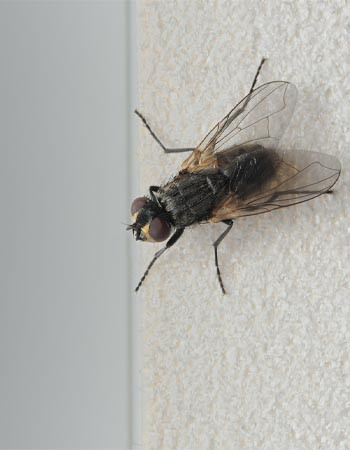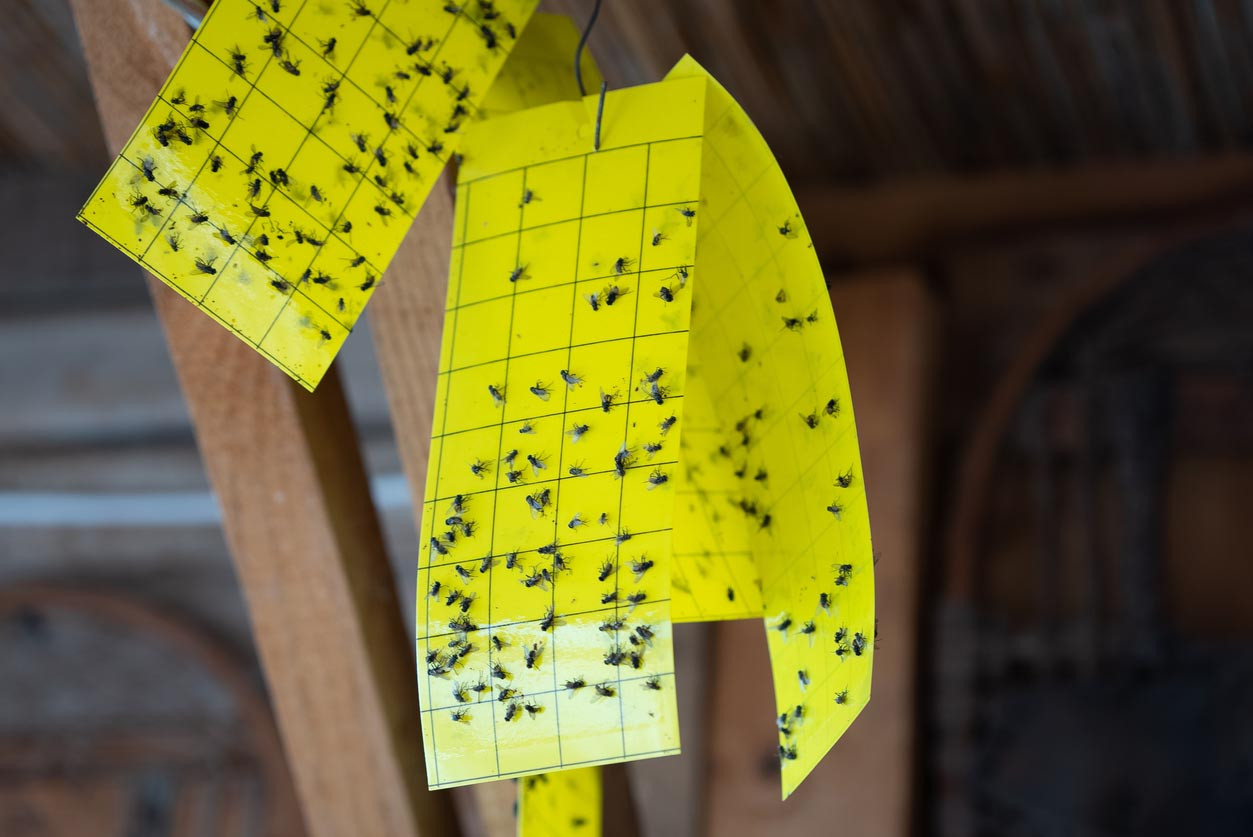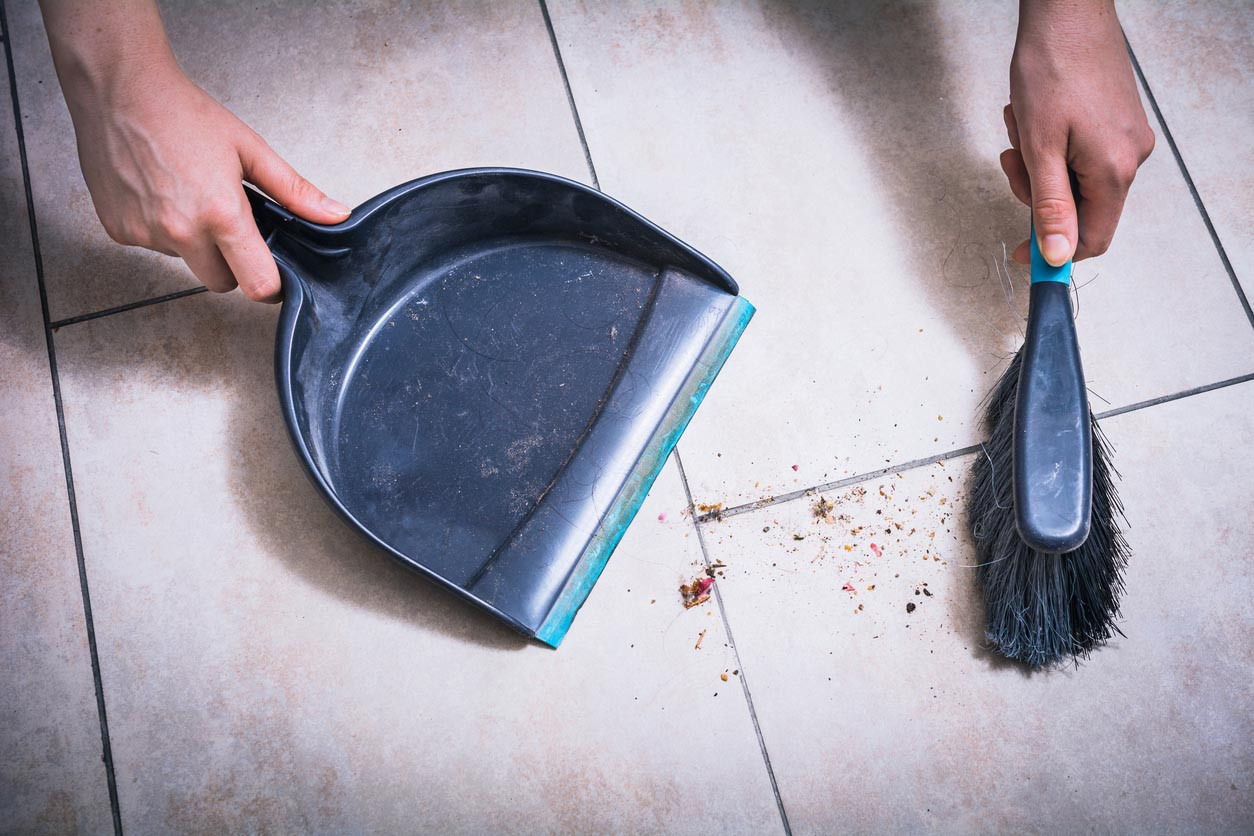Phorid flies in house can be a real nuisance, but don’t worry, Flyermedia.net is here to help you understand how to eliminate these pests and prevent future infestations with easy-to-follow steps. Identifying their breeding grounds and employing effective cleaning strategies are essential for regaining control of your living space. So, learn about fly control, sanitation practices and preventing future breeding sites from the information below.
1. What are Phorid Flies and Why are They in My House?
Phorid flies, also known as humpbacked flies or coffin flies, are small, brownish-black insects that are commonly found in homes. Their presence is often linked to decaying organic matter, making your house an unintentional breeding ground.
1.1 What Do Phorid Flies Look Like?
Phorid flies are small, typically measuring about 1/8 inch in length, and have a distinctive humpbacked appearance. They range in color from tan to dark brown or black. Their erratic, jerky flight pattern is another key identifier.
1.2 Why are Phorid Flies Attracted to Homes?
Phorid flies are primarily attracted to decaying organic matter, which can include:
- Rotting Food: Unsealed garbage, spilled food, and even tiny crumbs can attract these flies.
- Moist Environments: Damp areas like leaky pipes, condensation, and overwatered plants provide ideal breeding conditions.
- Drains: Drains with accumulated organic matter are prime breeding sites.
- Dead Animals: In rare cases, dead animals in walls or crawl spaces can attract phorid flies.
1.3 Are Phorid Flies Dangerous?
While phorid flies don’t bite, they can pose a health risk. According to the Illinois Department of Public Health, they can carry and transmit disease-causing bacteria to food and surfaces. Therefore, it’s crucial to eliminate them to maintain a clean and healthy home environment.
 A close up of a fly.
A close up of a fly.
2. How to Identify the Source of a Phorid Fly Infestation?
Effectively getting rid of phorid flies in house requires pinpointing their breeding source. This is the first and most crucial step.
2.1 Where Should I Look for Phorid Fly Breeding Sites?
To find the source, inspect the following areas:
- Drains: Check kitchen and bathroom drains for signs of buildup.
- Garbage Disposals: These can accumulate organic matter quickly.
- Under Appliances: Look under refrigerators, stoves, and dishwashers.
- Potted Plants: Overwatered plants can create a breeding ground.
- Leaks: Inspect around sinks, pipes, and any areas with potential leaks.
2.2 What Signs Indicate a Breeding Site?
Look for these signs:
- Small, White Larvae: These are the larvae of phorid flies.
- Pupae: These are small, brown, capsule-shaped pupae.
- High Fly Activity: Areas with a high concentration of adult flies are likely near a breeding site.
2.3 Why is Finding the Source So Important?
According to Thomas Olschewske, Region Technical Training Manager at Arrow Exterminators, “When dealing with a positively identified phorid fly, we need to locate what is referred to as ‘thick water.’ Thick water is stagnant water that has started growing thick.” Addressing the source directly eliminates the breeding ground, preventing the flies from multiplying.
3. How to Clean Up Messes and Eliminate Food Sources to Prevent Phorid Flies?
Maintaining a clean environment is crucial in preventing and eliminating phorid flies. Here’s how to do it effectively.
3.1 Why is Cleanliness Important in Phorid Fly Control?
Phorid flies thrive on decaying organic matter. Removing potential food sources eliminates their breeding and feeding sites. Cleaning effectively complements other control methods and ensures long-term success.
3.2 What Cleaning Steps Should I Take to Prevent Phorid Flies?
- Clean Kitchen Surfaces: Wipe down countertops, sinks, and floors daily to remove crumbs and spills.
- Inspect Under Appliances: Regularly clean under refrigerators, stoves, and dishwashers, where food particles can accumulate.
- Dispose of Food Waste Properly: Keep garbage bins tightly sealed and empty them frequently.
- Address Spills Immediately: Clean up any spills as soon as they occur to prevent attracting flies.
- Clear Rotting Matter: Remove decaying vegetation and organic debris from your yard and around your home’s perimeter.
3.3 What Cleaning Products are Best for Preventing Phorid Flies?
Use these products for effective cleaning:
- Disinfectant Cleaners: Use disinfectant cleaners to kill bacteria and remove food residues.
- Enzyme Cleaners: These are effective for breaking down organic matter in drains and hard-to-reach areas.
- Bleach Solutions: A diluted bleach solution can be used to disinfect surfaces, but use cautiously and avoid mixing with other chemicals.
4. How to Clean Drains to Eliminate Phorid Flies?
Cleaning drains is a crucial step in eliminating phorid flies, as drains often harbor the organic matter they need to breed.
4.1 Why Do Phorid Flies Breed in Drains?
Drains accumulate organic materials like food particles, hair, and grease, which provide an ideal breeding environment for phorid flies. The moist, dark conditions further promote their growth.
4.2 How Can I Clean Drains to Get Rid of Phorid Flies?
Follow these steps to clean your drains effectively:
- Flush with Hot Water: Start by flushing the drain with hot water for several minutes to loosen debris.
- Use a Drain Cleaner: Opt for a biological drain cleaner containing enzymes and bacteria to break down organic matter without harming plumbing.
- Scrub the Drain: Use a scrub brush or a specialized drain brush to remove any remaining residue from the drain walls.
- Plumber’s Snake: For stubborn clogs, use a plumber’s snake to dislodge debris deeper in the pipes.
- Rinse Garbage Disposal: According to Thomas Olschewske, rinse the garbage disposal after each use, ensuring you turn off the disposal before turning off the water to prevent organic buildup.
4.3 What Types of Drain Cleaners are Effective Against Phorid Flies?
- Biological Drain Cleaners: These contain enzymes and bacteria that break down organic waste.
- Enzyme-Based Sprays: Applying enzyme-based sprays into the drain can help eliminate residual organic matter.
- Avoid Harsh Chemicals: Harsh chemical drain cleaners can damage your pipes and are not as effective as biological solutions for organic matter.
 Flies are stuck on yellow sticky tape.
Flies are stuck on yellow sticky tape.
5. How to Identify and Address Moisture Issues to Eliminate Phorid Flies?
Moisture issues can create ideal breeding grounds for phorid flies. Identifying and addressing these issues is essential in controlling infestations.
5.1 Why are Moisture Issues a Problem?
Phorid flies are attracted to damp environments where they can lay their eggs and find decaying organic matter to feed on. Moisture provides the perfect conditions for organic materials to decompose, creating an attractive breeding site.
5.2 Where Should I Look for Moisture Issues?
- Under Sinks: Check for leaks and condensation.
- Around Pipes: Inspect pipes for leaks or cracks.
- In Bathrooms: Look for standing water and damp areas.
- Basements and Crawl Spaces: These areas are prone to moisture buildup.
- Around Toilets: Ensure toilets are functioning correctly and the seals are intact.
5.3 What Steps Should I Take to Address Moisture Issues?
- Repair Leaks: Fix any leaky pipes, faucets, or fixtures immediately.
- Improve Ventilation: Ensure bathrooms and basements are well-ventilated to reduce moisture.
- Use Dehumidifiers: Place dehumidifiers in damp areas to reduce humidity.
- Replace Water-Damaged Materials: Replace any water-damaged walls, floors, or materials promptly.
- Check A/C Units: Ensure A/C condensation pumps are functioning correctly to prevent water buildup.
5.4 What Happens if I Ignore Moisture Issues?
Ignoring moisture issues can lead to:
- Mold Growth: Damp environments encourage mold growth, which can cause health problems.
- Structural Damage: Water damage can weaken the structure of your home.
- Increased Pest Infestations: In addition to phorid flies, other pests like mosquitoes and cockroaches thrive in moist conditions.
6. How to Use Phorid Fly Traps Effectively?
Traps are a useful tool in managing phorid fly populations. Understanding how to use them effectively can significantly reduce infestations.
6.1 What Types of Traps Can I Use to Catch Phorid Flies?
- Sticky Traps: These traps use an adhesive surface to capture flies.
- Homemade Traps: Apple cider vinegar traps are a simple and effective DIY solution.
- Commercial Fly Traps: These traps often use bait or UV light to attract and capture flies.
6.2 Where Should I Place Phorid Fly Traps?
Place traps in areas where you’ve seen phorid flies, such as:
- Near Drains: Drains are common breeding sites.
- Garbage Disposals: These areas accumulate organic matter.
- Under Appliances: Food particles often collect under appliances.
- Moist Areas: Place traps near any areas with moisture issues.
6.3 How Do Sticky Traps Work for Phorid Flies?
Sticky traps attract phorid flies with bait or color and capture them on an adhesive surface. They are a good way to monitor fly activity and reduce the adult fly population.
6.4 How Do I Make an Apple Cider Vinegar Trap?
To make an apple cider vinegar trap:
- Fill a container: Fill a small bowl or jar with apple cider vinegar.
- Add dish soap: Add a few drops of dish soap to break the surface tension.
- Cover with plastic wrap: Cover the container with plastic wrap and poke small holes in it.
- Place the trap: Place the trap in areas where you’ve seen phorid flies.
6.5 How Often Should I Check and Replace Traps?
Check traps regularly and replace them when they are full or no longer effective. Change the apple cider vinegar solution in homemade traps every few days to keep them fresh and attractive to flies.
7. Why Consider Professional Pest Control for Phorid Flies?
While DIY methods can be effective, sometimes professional help is necessary to eliminate phorid flies completely.
7.1 When Should I Consider Hiring a Pest Control Professional?
Consider professional help if:
- DIY Methods Fail: If you’ve tried DIY methods and the infestation persists.
- Large Infestation: If you have a large or widespread infestation.
- Unknown Source: If you can’t locate the source of the infestation.
- Recurring Problem: If the infestation keeps coming back.
7.2 What Can a Pest Control Professional Do That I Can’t?
Pest control professionals can:
- Identify Hidden Breeding Sites: They have the expertise to find hidden breeding sites that you might miss.
- Comprehensive Treatment Plans: They can implement comprehensive treatment plans tailored to your specific situation.
- Specialized Equipment: They have access to specialized equipment and treatments not available to the public.
- Ongoing Maintenance: They can offer ongoing maintenance and prevention strategies to keep phorid flies from returning.
7.3 How Do I Choose a Pest Control Professional?
- Check Credentials: Ensure the professional is licensed and certified.
- Read Reviews: Look for online reviews and testimonials.
- Get Multiple Quotes: Compare quotes from different professionals.
- Ask About Methods: Inquire about their treatment methods and ensure they are safe and effective.
7.4 How Much Does Professional Pest Control Cost?
The cost of professional pest control varies depending on the extent of the infestation and the treatment methods used. Get a detailed estimate from several professionals to compare costs.
 A close up of a person sweeping dirty tiles with a dustpan.
A close up of a person sweeping dirty tiles with a dustpan.
8. Tips for Preventing Phorid Flies in the Future?
Preventing phorid flies from returning involves maintaining a clean and dry environment and addressing potential breeding sites promptly.
8.1 What Ongoing Cleaning Practices Should I Maintain?
- Regular Cleaning: Continue to clean kitchen surfaces, sinks, and floors regularly.
- Drain Maintenance: Clean drains monthly with a biological drain cleaner.
- Garbage Disposal Care: Rinse the garbage disposal after each use and clean it regularly.
- Appliance Checks: Periodically check under appliances for spills and crumbs.
- Proper Food Storage: Store food in airtight containers and dispose of food waste properly.
8.2 How Can I Prevent Moisture Buildup?
- Fix Leaks: Repair any leaks promptly to prevent moisture buildup.
- Improve Ventilation: Ensure good ventilation in bathrooms and basements.
- Use Dehumidifiers: Use dehumidifiers in damp areas to reduce humidity.
- Water Plants Carefully: Avoid overwatering plants and ensure proper drainage.
8.3 Are There Natural Ways to Prevent Phorid Flies?
- Essential Oils: Some essential oils, like peppermint and eucalyptus, can repel flies.
- Herbs: Planting herbs like basil and lavender near doors and windows can help deter flies.
- Diatomaceous Earth: Food-grade diatomaceous earth can be sprinkled in areas where flies are present to dehydrate and kill them.
8.4 How Can I Keep My Yard From Attracting Phorid Flies?
- Remove Decaying Matter: Clear away decaying leaves, grass clippings, and other organic debris.
- Maintain Compost Piles: Keep compost piles away from the house and ensure they are properly maintained.
- Proper Drainage: Ensure your yard has good drainage to prevent standing water.
9. Addressing Common Myths About Phorid Flies?
There are several misconceptions about phorid flies. Understanding the facts can help you manage them more effectively.
9.1 Myth: Phorid Flies Bite.
Fact: Phorid flies do not bite. They are primarily a nuisance because they can carry bacteria.
9.2 Myth: Phorid Flies Only Live in Drains.
Fact: While drains are a common breeding site, phorid flies can breed anywhere there is decaying organic matter and moisture.
9.3 Myth: Phorid Flies Are the Same as Fruit Flies.
Fact: Phorid flies and fruit flies are different species. Phorid flies have a humpbacked appearance and are attracted to decaying matter, while fruit flies are attracted to ripe and fermenting fruits.
9.4 Myth: Chemical Sprays Are the Best Way to Get Rid of Phorid Flies.
Fact: While chemical sprays can kill adult flies, they do not address the source of the infestation. It’s more effective to focus on eliminating breeding sites and using traps.
9.5 Myth: Phorid Flies Are Only a Problem in Dirty Homes.
Fact: While cleanliness helps, phorid flies can infest even the cleanest homes if there are hidden sources of decaying organic matter or moisture.
10. FAQ: Answering Your Questions About Phorid Flies
Here are some frequently asked questions about phorid flies to help you better understand and manage these pests.
10.1 What Attracts Phorid Flies the Most?
Phorid flies are most attracted to decaying organic matter, such as rotting food, moist environments, and drains with accumulated debris.
10.2 How Long Do Phorid Flies Live?
The lifespan of a phorid fly is typically around 30 days, but this can vary depending on environmental conditions.
10.3 Can Phorid Flies Cause Any Damage to My Home?
Phorid flies themselves don’t cause structural damage, but their presence indicates potential problems with moisture or decaying organic matter, which can lead to other issues like mold growth.
10.4 Are Phorid Flies More Active During Certain Times of the Year?
Phorid flies are generally more active during warmer months when conditions are more favorable for breeding.
10.5 What Should I Do if I Find a Dead Animal Attracting Phorid Flies?
If you suspect a dead animal is attracting phorid flies, contact a professional pest control service or animal removal service to safely remove the animal and address the infestation.
10.6 Can Phorid Flies Fly Long Distances?
Phorid flies are not strong fliers and typically stay close to their breeding sites. However, they can be carried by wind or air currents over longer distances.
10.7 What is the Best Way to Prevent Phorid Flies in My Business?
For businesses, maintaining strict sanitation practices, regularly cleaning drains, and addressing moisture issues are essential for preventing phorid fly infestations.
10.8 Can Phorid Flies Transmit Diseases to Humans?
Phorid flies can carry and transmit disease-causing bacteria to food and surfaces, so it’s important to eliminate them to maintain a healthy environment.
10.9 How Quickly Can a Phorid Fly Infestation Get Out of Control?
Phorid flies can reproduce quickly, so an infestation can escalate rapidly if breeding sites are not addressed promptly.
10.10 Is It Possible to Completely Eliminate Phorid Flies From My Home?
With thorough cleaning, addressing moisture issues, and using traps or professional pest control, it is possible to completely eliminate phorid flies from your home.
Addressing a phorid fly infestation requires a comprehensive approach, from identifying and eliminating breeding sources to maintaining a clean and dry environment. Whether you choose DIY methods or professional pest control, the key is to act promptly and consistently.
Are you ready to take control of your home and eliminate those pesky phorid flies? Visit Flyermedia.net for more expert tips, detailed guides, and the latest solutions to keep your living space pest-free. Don’t let phorid flies take over – discover the best strategies and resources now at flyermedia.net!
